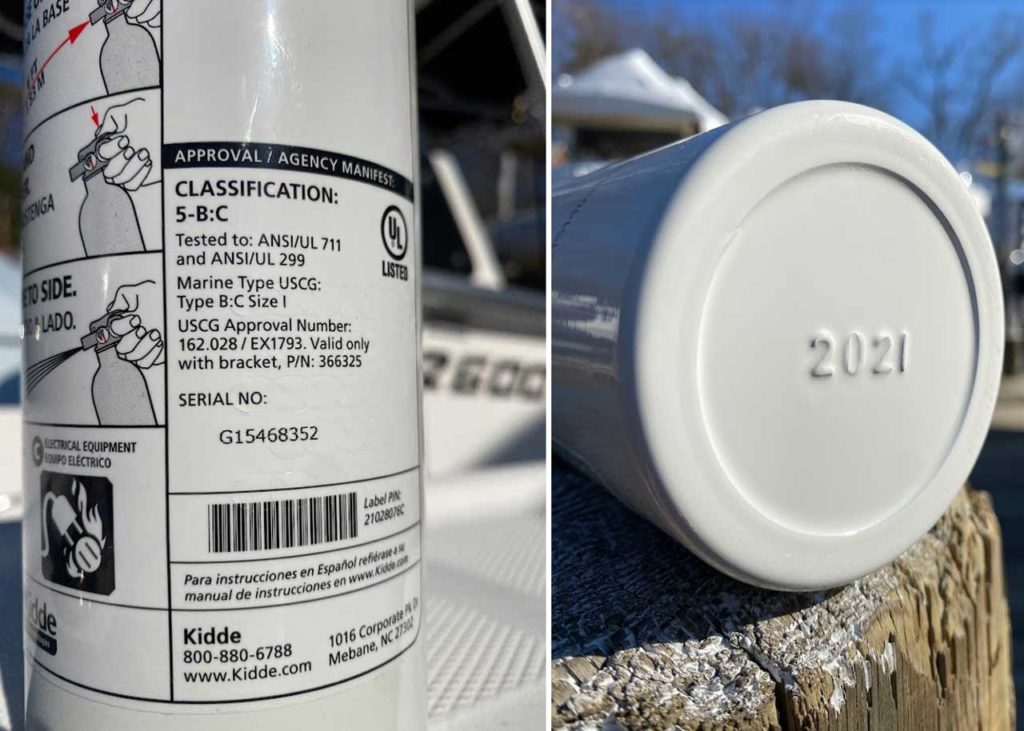12 year expiration for disposables and different carriage requirements for older, newer model year vessels.

ANNAPOLIS, Md., February 15, 2022 — A rite of passage for every boater is the annual spring commissioning. Newly added to the boat owners to-do list this spring will be to check all disposable (non-rechargeable) fire extinguisher dates of manufacture, as well as the label for their U.S. Coast Guard classification.
That’s because a new U.S. Coast Guard regulation beginning April 20 for disposable fire extinguishers mandates a 12-year expiration date from the date of manufacture. Boaters can find the manufacture date stamped into the bottom of the bottle or near the UL label. This may be two or four digits — if it is two, as in 08, that means 2008. Additionally, while the new regulation does not change the type (U.S. Coast Guard-rated) or quantity or requirement for USCG approved fire extinguishers aboard, it does specify the minimum Underwriter Laboratory (UL) classification of extinguishers to be carried aboard certain vessels — depending on the boat’s model year.
This is the result of phasing out older “B-I” and “B-II” labels for newer “5-B” “10-B” and “20-B” extinguisher classifications. The number in this new rating refers to the size in square feet of the potential fire the device is suitable to extinguish and not the exact weight of the dry chemical inside the bottle.
Vessels on the water today that are less than 26 feet and model year 2017 or older may continue to carry older, dated or undated “B-I” or “B-II” disposable extinguishers. However, when they are no longer serviceable or have reached 12 years of age since manufacture, they must be replaced with newer class “5-B” or greater extinguishers. Boats less than 26 feet and 2018 model year or newer must carry unexpired “5-B” “10-B” or “20-B” fire extinguishers. Having older “B-I” and “B-II” types do not meet the new carriage requirements.
Many retailers today offer “10-B” class fire extinguishers, which may be a good choice as they exceed U.S. Coast Guard minimum carriage requirements for boats under 26 feet, while at the same time giving boaters more extinguishing coverage. For boats 26 feet or greater, however, having one “10-B” aboard does not equal two 5-Bs. Only a “20-B” classification meets the requirement to carry two “5-B” extinguishers. For a look at how many and what type of fire extinguishers are needed aboard all recreational boats up to 65 feet, go to BoatUS.org/Fire-Extinguishers.
BoatUS strongly recommends going beyond the regulation’s minimum requirements. The results from a Foundation-sponsored boat burn showed that one extinguisher may give very little time to make an emergency call or potentially prepare to abandon your vessel.
BoatUS also notes that most U.S. Coast Guard disposables on the market today carry at least a dual B:C rating, able to douse both liquids and electrical fires, and some boat owners wisely prefer triple rated A:B:C extinguishers, adding a third protection for combustible fires.
To be serviceable, a portable extinguisher must have a pressure gauge indicating an operable range, lock pin firmly installed, clean discharge nozzle, and no significant corrosion or damage. Some more recently manufactured portable fire extinguishers aboard boats today may carry both old and new labeling, for example, having simultaneous “B-I” and “5-B” classifications.
There are no changes to rechargeable or fixed-mount (i.e., engine room) extinguisher regulations. They continue to require regular maintenance and servicing, typically done annually by a technician.
“This new U.S. Coast Guard expiration date regulation aligns with the 12-years recommended by the National Fire Protection Association,” said BoatUS Foundation Assistant Director of Boating Safety Ted Sensenbrenner. “We expect that the U.S. Coast Guard Auxiliary and United States Power Squadrons vessel safety check program will soon include this new regulation as part of their free, no-penalty vessel exams. Because this change affects a critical piece of safety equipment aboard your boat, we also expect the U.S. Coast Guard will initially focus on education. You may want to start checking extinguishers now while your boat may be ashore this winter.”
Sensenbrenner adds, “Also take a look now to ensure your fire extinguishers are readily accessible. You can buy only the bracket if you don’t have one and mount your extinguishers where they need to be — at points of egress, at the helm, and near the engine and fuel supply. Burying them in the bottom of a compartment ensures they will be hard to reach when you need them the most. Familiarizing yourself with the PASS method (Point, Aim, Squeeze, and Sweep) will prepare you for fighting a small fire aboard.”
For more information on the new requirement, as well as frequently asked questions and an infographic, go to www.uscgboating.org.
About the BoatUS Foundation for Boating Safety and Clean Water:
The BoatUS Foundation for Boating Safety and Clean Water is a national leader promoting safe, clean and responsible boating. Funded primarily by donations from the more than 800,000 members of Boat Owners Association of The United States (BoatUS), the nonprofit provides innovative educational outreach directly to boaters and anglers with the aim of reducing accidents and fatalities, increasing stewardship of America’s waterways and keeping boating safe for all. A range of safe and clean boating courses – including the nation’s largest free online boating safety course – can be found at BoatUS.org/Courses.
About the Water Sports Foundation
Headquartered in Orlando, FL, the Water Sports Foundation (WSF) is the non-profit educational arm of the Water Sports Industry Association (WSIA.net). The WSF National Boating Safety Media Center is produced under a grant from the Sport Fish Restoration and Boating Trust Fund, administered by the U.S. Coast Guard.
For more information and to access boating safety resources, visit the new National Boating Safety Media Center at www.watersportsfoundation.com/media/ or contact WSF Communications Director Wanda Kenton Smith at Wanda@WaterSportsFoundation.com; text 407.697.8055 or WSF Publicity Specialist Joel Staley at Joel@WaterSportsFoundation.com or text 407.242.9994.
###
PHOTO CAPTION: A new U.S. Coast Guard regulation for disposable fire extinguishers mandates a 12-year expiration date from the date of manufacture. Regulation aims to increase use of a newer class of disposable fire extinguishers. A “5-B:C” class is shown here.



